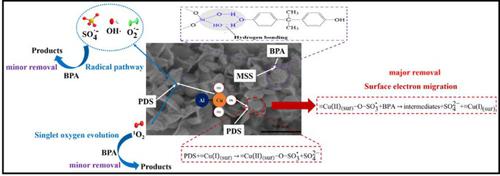Frontiers of Chemical Science and Engineering ( IF 4.3 ) Pub Date : 2023-06-22 , DOI: 10.1007/s11705-023-2327-7 Fulong Wang , Liang Sun , Ziyu Zhang , Fengkai Yang , Jinlong Yang , Weijian Liu

|
Herein, Cu–Al bimetallic oxide was synthesized and mixed with mesoporous silica spheres via a simple hydrothermal method. The prepared sample was then analyzed and employed to activate potassium peroxy-disulfate for bisphenol A removal. Based on the results of X-ray diffraction, scanning electron microscopy, and energy dispersion spectroscopy, Cu–Al bimetallic oxide was determined as CuO-Al2O3, and mesoporous silica spheres were found around the these particles. At 30 min, a bisphenol A degradation level of 90% was achieved, and it remained at over 60% after five consecutive cycles, indicating the catalyst’s superior capacity and stability. In terms of removal performance, the radical pathway (including \({\rm{SO}}_4^{\cdot - }\), OH·, and \({\rm{O}}_2^{\cdot - }\)) and singlet oxygen (1O2) played minor roles, while electron migration between bisphenol A, potassium peroxydisulfate, and the catalyst played a dominant role. The introduction of Al2O3 promoted the formation of surface oxygen vacancies, which improved ligand complex formation between potassium peroxydisulfate and the catalyst, thereby facilitating electron migration. Furthermore, mesoporous silica spheres augment not only enhanced bisphenol A adsorption but also alleviated Cu leaching. Overall, this work is expected to provide significant support for the rational development of catalysts with high catalytic activity for persulfate activation via surface electron migration.
中文翻译:

使用介孔二氧化硅球增强过硫酸盐的活化,增强铜铝双金属氧化物颗粒的双酚 A 降解
在此,通过简单的水热法合成了铜铝双金属氧化物并与介孔二氧化硅球混合。然后对制备的样品进行分析并用于活化过二硫酸钾以去除双酚A。根据X射线衍射、扫描电子显微镜和能量色散光谱的结果,Cu-Al双金属氧化物被确定为CuO-Al 2 O 3,并且在这些颗粒周围发现了介孔二氧化硅球。30 min时双酚A降解率达到90%,连续5次循环后双酚A降解率仍保持在60%以上,表明该催化剂具有优异的容量和稳定性。在去除性能方面,自由基途径(包括\({\rm{SO}}_4^{\cdot - }\)、 OH· 和\({\rm{O}}_2^{\cdot - }\) )和单线态氧 ( 1 O 2 ) 起次要作用,而双酚 A、过二硫酸钾和催化剂之间的电子迁移起主导作用。Al 2 O 3的引入促进了表面氧空位的形成,从而改善了过二硫酸钾和催化剂之间的配体络合物形成,从而促进了电子迁移。此外,介孔二氧化硅球不仅增强了双酚 A 的吸附,还减轻了铜的浸出。总的来说,这项工作有望为合理开发具有高催化活性的通过表面电子迁移活化过硫酸盐的催化剂提供重要支持。





















































 京公网安备 11010802027423号
京公网安备 11010802027423号